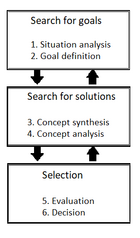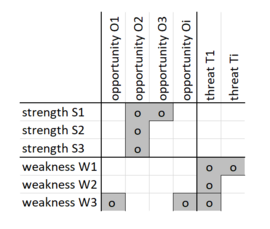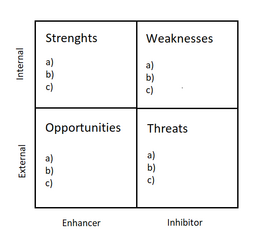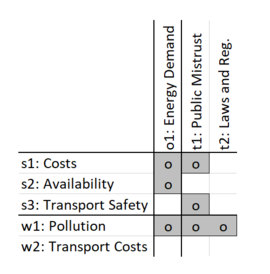SWOT Analysis
Developed by Henning Duwe
SWOT is a commonly used method that helps to systematically analyze a company's strategic position [1] by dividing it into the four categories “Strengths”, “Weaknesses”, “Opportunities” and “Threats” to examine their influence and how these attributes interact with each other. The goal is to get an objective and unbiased view of the organization (internal view) and the environment (external view).[2] It can be described as a planning technique for Situation[3] or Data Analysis[4]or as a tool for “identifying, relating, and making performance improvement decisions within context.”[2] The results can then be used as a foundation to formulate goals and to search for solutions.[3]
SWOT is used on many occasions. Three situations, in which the method is particularly applicable are shown below:
- When analyzing performance. The effects of the internal and external dimensions are being surveyed and how they have an influence on the output of the group. The effectiveness of the group can be another dimension of the survey.
- When executing cause analysis. SWOT can examine which practices, tools or methods should still be used in the future and which should be dropped.
- As a part of an improvement process, by regularly checking and updating the strengths, weaknesses, opportunities and strengths when new influences arise.[2]
Contents |
Description of the Tool

The Role of SWOT in Project, Program and Portfolio Management
Due to its basal approach to analyze a problem, SWOT can be used in various applications. In terms of Project, Program and Portfolio Management it is commonly used in the planning process to analyze the future situation of the Project, Program or Portfolio with its strengths, weaknesses, opportunities and threats. Being a method for situation analysis, it is used as the first step of the Problem Solving Cycle (PSC).[3]
The PSC is a procedure that aims to solve problems and create the best possible solution. According to Rainer Züst and Peter Troxler, it can be divided into three major and six minor steps (see Figure 1). These steps are not definite. In fact, the later steps can have effects on the earlier steps and reassessments may be necessary:[3]
- The search for goals, consisting of the situation analysis and the goal definition,
- the search for solutions, consisting of the concept synthesis and concept analysis and
- the selection, consisting of the evaluation and decision.
A core question during the situation analysis is "What do we want to achieve?"[3] To successfully aim at the desired future state, it is necessary to take all uncertainties into account. SWOT helps project, program and portfolio managers to systematically consider these uncertainties and to anticipate changes in the environment of the project, program or portfolio.[3] By executing a SWOT-Analysis, a better prediction of external factors and future developments is possible and great knowledge of internal factors and the situation is gained. This makes it a powerful tool for the first step in the Problem Solving Cycle.
Full SWOT-Analysis

SWOT can be executed in different ways, but they all share the view on internal and external enhancers and inhibitors of organizational performance.[1] At the beginning of the analysis, strengths and weaknesses of the specific organization, project or the whole business area are identified. The next step is detecting which opportunities and which threats result from this.[4] By doing so, it is important to focus on the key issues and not make the lists too long. Generally, around 6-8 issues for the internal view (strengths and weaknesses) and 6-8 issues for the external view (opportunities and threats) are sufficient. Claire Capon, Professor of the Staffordshire University; defines the four dimensions of the analysis as follows:[5]
- Strength: an internal enhancer of competence, a valuable resource, or attribute
- Weakness: an internal inhibitor of the competence, resources, or attributes necessary for success
- Opportunity: an external enhancer of performance that can be pursued or exploited to gain benefit
- Threat: an external inhibitor of performance that has the potential to reduce accomplishments
The full SWOT-Analysis structures the different causes of the strengths, weaknesses etc. especially due to their urgency for action.[3] But it also examines to which degree the strengths of the organization could offset the threats and determines if the weaknesses possibly restrain the opportunities.[4]
After that, strengths, weaknesses, opportunities and threats which have the same cause can be put into groups since they often need the same or similar actions. For each of the four fields in the matrix, a basic approach can be defined:[3]
- Strengths/opportunities: build on strengths and use opportunities
- Strengths/threats: build on strengths and minimize threats
- Weaknesses/opportunities: repair weaknesses and use opportunities
- Weaknesses/threats: repair weaknesses and minimalize threats
For each of these segments, an own evaluation is made. The ultimate goal is to have an overview of the issue from the most important perspectives and therefore have a basis for upcoming decisions under uncertainty. One of the strengths of SWOT is that it raises attention to the context, in which the results of the decision will be implemented. In a traditional SWOT-Analysis, contextual factors like an increasing market fragmentation categorized as a threat are classified and discussed by the participants. By doing so, a better understanding of the context can be accomplished.[2]
Partial SWOT-Analysis

Often the SWOT-Analysis is ended prematurely, which is the reason between the distinction of "partial" and "full" SWOT. Many companies use SWOT just as a structure for listing or "as a method of initiating discussion",[1] not as an analysis tool. This is not the scope of the method, but since this way of executing SWOT is spread widely among enterprises, this circumstance has to be accepted. That is why it can be helpful to point out the difference between a partial and full execution of SWOT before beginning so that the aim is clear and no false hopes for the output are raised. In the case of partial SWOT, the results will most likely be no more than a description and not a complete analysis.
Still, in this “Partial SWOT” the company gets insights from the internal view with the dimensions “Strengths” and “Weaknesses” as well as from the environment with the “Opportunities" and "Threats” as external factors. For the partial SWOT, a 2-by-2 matrix is commonly used as a structure (see Figure 3).
The advantages of this simplified analysis are that each factor can be examined individually while still having a broad view on the matter. Additionally, this way of executing SWOT is faster and easier than the way the SWOT will be executed in the following chapters.[2] On the other hand, the analysis is less deep and interdependencies and synergies are getting ignored.
Application: Full SWOT-Analysis on Coal Energy
A concrete example of a full SWOT-Analysis on the use of coal energy compared to other fossil fuels in Thailand based on the paper "Assessing Coal Use in Thailand: Current and Future Trends"[6] will be executed here. The content of the matter shall not be the middle of the attention, but rather the way a full SWOT-Analysis is performed. Still, this example ties to Project, Program and Portfolio Management:
According to the PMI Talent Triangle, project managers should have the following three competencies:[7]
- The competence of technical project management,
- the competence of strategic and business management and
- the competence of leadership.
A scenario, where the content of this SWOT could be relevant is the decision if a local electricity supplier in Thailand should strengthen his engagement in coal energy or drop it. Considering the Talent Triangle, we see that first, a good project, program or portfolio manager should be aware of the technical background of this decision and has the knowledge to compare coal with other sources of energy. Second, he has the expertise in the energy industry to realize which energy source will enhance the performance of his electricity supplier (strategic and business management). And third, by having this knowledge, he motivates and directs his team on the right path to achieve their goals.
Assessment of Strengths, Weaknesses, Opportunities and Strengths
Strengths
- Overall Costs: Coal is a comparably cheap source for electricity production. The high availability and accessibility are reasons for this. In distinction to oil or natural gas, it does not need pipelines as an infrastructure. The prices are not fluctuating as in the oil business. According to Prurapark et al., the costs of coal are low compared to nuclear power and solar power in that region.
- Availability: Compared to other fossil fuels like natural gas and oil, there are significantly higher reservoirs of coal in Thailand. The reserve to production ratio (R/P ratio), which "represents the number of years that current reserves would last if their rate of use did not change"[8] is significantly higher than those of its competitors. With the current usage, coal has a R/P ratio of 63 years, while the R/P ratio of natural gas and oil is 5 and 2 years.
- Safety in Transportation (Overseas): The transportation of coal is said to be safer and easier than the transportation of oil and natural gas. While leaks of coal overseas are unfortunate, a leak of oil is disastrous. Transporting natural gas is also highly complicated since it has to be cooled down to liquified natural gas due to efficiency reasons.
Weaknesses
- Air Pollutants from Coal: One of the biggest weaknesses of using coal as a source for energy production is air pollution. Even in comparison with oil and natural gas, the emission figures are quite high. In regards to carbon dioxide, one of the main drivers of climate change, producing one unit of energy using coal emits 40 % more carbon dioxide than oil respectively 88 % more carbon dioxide than natural gas. But it also has the highest carbon monoxide, nitrogen oxides, sulfur dioxide, particulates and mercury emissions, which makes coal an unfavorable source for energy production.
- Cost of Coal Transportation: Due to the amounts of coal needed for energy production and the fact, that coal can not be packed as tightly as oil or gas, the cost of coal transportation is high. This issue can be met by having short distances from the coal mines to the power plants, but since the distance of transferring energy should also be kept as short as possible, this requires the coal mines to be close to the cities, which is not always the term.
Opportunities
- Increasing Demand for Energy: According to Pinyo Meechumna, professor and specialist regarding coal and sustainable energy, the population and economy in Germany have reached a plateau and this leads to a state of electric saturation. This means that there will be little change of the centralized electricity production such as nuclear power, coal et cetera and decentral, renewable energy like solar plants are built. In contrast, growing countries such as Thailand are not electrically saturated and therefore offer the opportunity of rising demand for the usage of coal. The International Energy Agency estimates that despite the decreasing usage of coal in some modern states, the need for coal will grow by 3 % from 2020 until 2022, due to its low costs and high accessibility.
Threats
- Public Mistrust of Coal Energy: Since the usage of coal comes with air pollution and emitting greenhouse gas, its usage is questioned by the public which hinders the further use of this source of energy.
- Ambiguity in Laws and Regulations: Even though the use of coal as a source of energy is today clearly allowed in Thailand, different trends still lead to uncertainty regarding laws and regulations. Diverse sectors are responsible for coal usage which leads to unclear competencies. There is a lack of specific regulations that lower the trust in long-term stable conditions for burning coal. Furthermore, global warming and the pollution of the environment are factors, which are questioning energy production with the usage of coal in the future.
Analysis of SWOT and Evaluation of needed actions

After assessing the 4 dimensions, they can be put into a matrix to examine interdependencies and necessary actions. Before doing this, it is helpful to rank the findings by their importance to the organization to prioritize the analysis. In our case, the founded points are already ranked.
- Strengths/opportunities: The opportunity of increasing energy demand can be used to build new coal power plants as the growing population of Thailand seeks sources of energy, which are cheap and available for centuries.
- Strengths/threats: The threat of public mistrust can be met with the strengths of costs and transport safety. An option would be a marketing campaign, in which the upsides of coal energy are communicated to the public to lower the mistrust.
- Weaknesses/opportunities: A way of using the opportunity of increasing energy demand and repair the weakness of pollution is the implementation of state-of-the-art technology in every new coal power plant to reduce their emissions to a minimum level.
- Weaknesses/threats: The big weakness of pollution is critical in combination with public mistrust and possibly stricter laws and regulations. This issue can be met by additionally improving the existing coal plants with filter technology to reduce the emissions. Another possibility is lobbying, with the goal of reducing the strictness of future regulations.
Discussion and Limitations
A weakness of SWOT-Analysis is the direct link between the quality of the input or data and the results. When the data is insufficient, lacks in accuracy, or is not available, the output of the analysis will most likely have poor quality.[2]
Terry Hill and Roy Westbrook surveyed different companies from 1993-1994 and how they use the SWOT-Analysis. There were diverse problems regarding the quality of the factors companies listed for the four dimensions:
- In many cases, the factors were not described precisely enough or were too universal to be useful, e.g. "performance" as a strength without further description. Even in later stages of the analysis, this issue was not fixed by defining the factors with more precision.
- In none of the surveyed cases, any proof for the suggestions for strengths, weaknesses etc. was provided, which inevitably leads to bad quality of the data and therefore of the analysis.
- On average, companies found and used 10 factors for each of the SWOT dimensions, which is disproportionate if the SWOT is not only used as a listing but as an analysis tool with the method explained above.
- When the same or similar factors were listed as a strength as well as a weakness, often no additional explanation was provided to understand this initiative contradiction.
- In some cases, employees did not differentiate clearly between external and internal factors.[1]
The SWOT-Analysis is often being executed without examining the interdependencies between these attributes as stated before. This makes the analysis easier, but the gained insights and information lack in depth. Terry Hill and Roy Westbrook therefore state: "The relevance and usefulness of any approach is in part related to the ability of those involved."[1]
In general, the SWOT-Analysis itself has the following limitations:
- There are no regulations for the lengths of the lists which can lead to insufficient use of SWOT.
- The tool requires no weighting of the factors.
- It is possible to list the same factor as strength and as a weakness.
- There is no necessity of verification for the factors.
- The tool offers no direct link for the implementation of the findings.[1]
What can it do, what can it not do?
SWOT offers a clear and sufficient structure to systematically analyze a company's strategic position. By executing a full analysis, valuable insights and links between the dimensions are won. When using this structure, it is less likely to forget or oversee factors that are important for the company's success.
But to achieve this, SWOT needs to be executed right. This requires trained employees that are familiar with the true aim of the analysis. The tool does not provide instructions on how to lift, verify and prioritize data and how to successfully implement the results. On the one hand, this makes the execution of the method more demanding than most people initially think. On the other hand, this approach offers a solid foundation for the next steps in the Problem Solving Cycle.
Annotated Bibliography
Hill, Terry and Westbrook, Roy: Long Range Planning, Vol. 30 (1997), Elsevier Science Ltd., pp. 46–52
The chapter "SWOT Analysis: It's Time for a Product Recall" from the book "Long Range Planning" written by Terry Hill and Roy Westbrook is a classic regarding criticism of SWOT. The two professors of the London Business School surveyed the way 20 medium- to large-sized companies from various sectors like food, textiles or engineering applied the SWOT-Analysis from 1993-1994. They found that most organizations lack in know-how of how to do the analysis and that the way they deployed it was ineffective. Due to major issues with the execution and results within these companies, they came to the conclusion that SWOT should be relinquished and better and newer methods should be used.
Watkins, Ryan and Leigh, Doug: Handbook of Improving Performance in the Workplace: Selecting and Implementing Performance Interventions, Vol. 2 (2010), Pfeiffer, pp. 115–140
The "Handbook of Improving Performance in the Workplace" by Ryan Watkins and Leigh Doug gives a broad view on how to improve human and organizational performance. On pp. 115-140, SWOT-Analysis is explained deeply and the distinction between the partial or "conventional" SWOT and the full SWOT is being introduced. The structure of executing SWOT is shown and explained in detail. Since it covers all relevant aspects of how the method should be executed, it is used as the core source for explaining the method in this article.
R. Prurapark and P. Asavaritikrai: Assessing Coal Use in Thailand: Current and Future Trends (2020), Springer Nature Singapore Pte Ltd., pp. 83–92
As the title suggests, Prurapark et al. assessed coal use in Thailand in their book. As a part of this, they executed a partial SWOT in which they tend to be pro-coal. One strength, namely "Clean Technology", has been disregarded since it is illogical and inconsistent to count this as a strength of coal energy while pollution is the main and most important weakness. Besides that, the chapter offers a deep view on a relevant topic for energy suppliers in that region, which were the reasons why this example has been chosen. The other strengths, weaknesses, opportunities and threats that were identified in the partial SWOT have been used as the foundation for the full SWOT-Analysis.
Rainer Zuest and Peter Troxler: No More Muddling Through (2006), Springer, pp. 35-39
No More Muddling Through - Mastering Complex projects in Engineering and Management by Rainer Zuest and Peter Troxler is a highly regarded book on the principles of system engineering and project management. In this article, it has been used to give a theoretical background and embed SWOT in the Problem Solving Cycle.
References
- ↑ 1.0 1.1 1.2 1.3 1.4 1.5 Hill, Terry and Westbrook, Roy: Long Range Planning Vol. 30, 1997, Elsevier Science Ltd, pp. 46–52.
- ↑ 2.0 2.1 2.2 2.3 2.4 2.5 2.6 Watkins, Ryan and Leigh, Doug: Handbook of Improving Performance in the Workplace: Selecting and Implementing Performance Interventions, Vol. 2, 2010, Pfeiffer, pp. 115–140.
- ↑ 3.00 3.01 3.02 3.03 3.04 3.05 3.06 3.07 3.08 3.09 3.10 Zuest, Rainer and Troxler, Peter: No More Muddling Through, 2006, Springer, pp. 35-39.
- ↑ 4.0 4.1 4.2 Project Management Institute: Guide to the Project Management Body of Knowledge, 2017, Project Management Institute, p. 415.
- ↑ Capon, Claire: Understanding Organisational Context, 2000, Prentice Hall, pp. 393-401.
- ↑ Prurapark, R. and Asavaritikrai, P.: Assessing Coal Use in Thailand: Current and Future Trends, 2020, Springer Nature Singapore Pte Ltd., pp. 83–92.
- ↑ Project Management Institue: The Standard for Program Management — Fourth Edition, 2017, Project Management Institute, pp. 56-57.
- ↑ Oxford University Press: Energy Systems and Sustainability: Power for a Sustainable Future, 2nd Ed., 2012, Oxford University Press, p. 114.